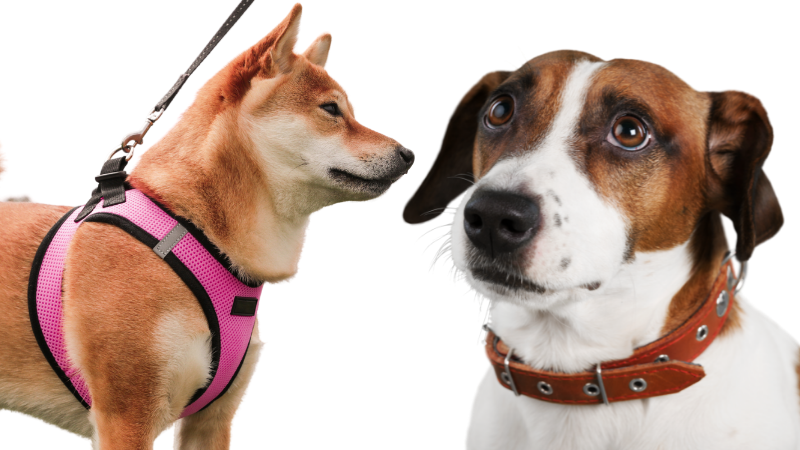Dogs are like human beings– they have varying needs and exhibit different traits, personalities, and physical attributes. What might be ideal for one dog may not be best for another.
Benefits of Collars
As the most traditional approach, collars are great for dogs as they are used for training and walking dogs. They can only be used every day as a good option for dogs that do not experience any respiratory or trachea issues. One good thing about using collars is that they can be used on any kind of dog irrespective of age, size, species, and so on.
Even when a dog tends to slip out of its collars which may be as a result of his physique or build, there are special collars suitable for such situations. One of such is the Martingale which is also known as a greyhound collar. It remains fitted around the dog’s neck even when the dog tries to pull or back up. so the collar is a more common choice because it is convenient.
Plus, an ID tag can be placed on the collar while the dog is either conveniently taken on a walk or left alone with a collar on its neck. Collars are also minimally invasive, so they can usually be worn 24/7 without issue.
Collars aren’t great for pulling, however. Whether your dog doesn’t have great leash manners or you want to be able to hold on the collar to keep them in control, pulling on the collar can cut off your dog’s airway which isn’t good for them. If you anticipate that your dog will pull against his collar a lot or if you want to be able to grab something to hold your dog back with, a collar is a poor choice.
Benefits of Harnesses
Harnesses are suitable for leashing untrained dogs that are sometimes very restless and irresistible. Some pulling dogs, such as small dogs, dogs that are not well trained to ignore distractions, and dogs with trachea or respiratory issues, a common problem with short-nosed dogs, can be safely leached with a harness.
Harnesses help to distribute and spread the pulling force exerted by the dog to other parts of the dog’s body because it secures around the body of the dog. Thus, the eruption of some common problems such as spine, neck, and windpipe injuries is significantly reduced.
They also have a hand hold on top of the harness, which is very nice to have when you need to grab your dog for quick control. For example, if you see a cat on your walk and your dog really likes trying to go after the cat, you could grab their harness and keep them right next to you.
With a harness, a dog is safely guarded. The five points of adjustment on a harness make it very difficult for a dog to wiggle itself out of the control of its owner or trainer. However, some dogs, like my huskies, have learned how to back themselves out of harnesses. So they aren’t full proof.
Harness also aren’t ideal for wearing all the time. They’re big and rub in multiple points on your dog. With prolonged use, you’ll probably notice some of the hair rubbing off on those spots, and occasionally sores. So they’re generally best to put on right before you leave for a trip then back off when you arrive home.
So is a Harness or Collar Better for Me?
Ultimately, only you can decided. If you’re not sure which one will work best for your dog, purchase a cheaper version of both and see which one you like best.
Many people use both for different reasons. For example, they’ll leave a collar on always so that their dog’s tags are always with them and only put a harness on for walks and adventures.
Or, in extreme cases like mine, I’ll use both a leash and a harness when I walk my dogs. I have huskies and like hiking in the mountains with them. If you know anything about huskies, you probably know that they’re not very reliable off leash and have a strong prey drive that could have them chasing a deer for miles until they’re hopelessly lost in the woods.
Once when we were hiking, one of my dog’s collars just snapped off. Thus ensued a heart attacked while I chased down my dog and then carried a very hyper and wiggly dog a couple miles back to the car without a leash. Not a great hike.
Then, on another hike by bigger boy husky backed himself out of his harness mid-hike. He wasn’t as tricky to get back to the car since he’s a momma’s boy and better behaved, but after these incidents I now use a collar and a harness. I connect them both to each other and then connect both to the leash as well. So far I haven’t had any situations with this set up. I’m sure people passing by may think it looks a bit excessive, but it’s not worth the risk of having another leashing incident and losing my dogs in the mountains.
So there you have it. Some of the pros and cons of using collars vs harnesses.




